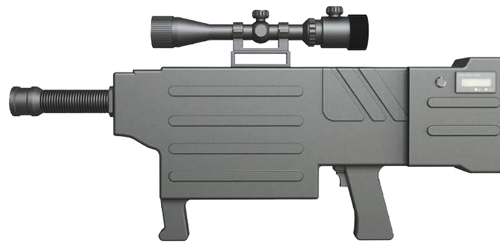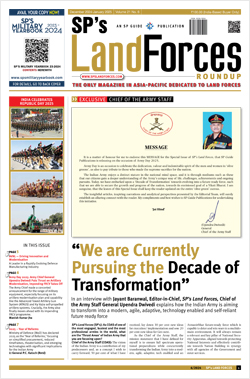INDIAN ARMED FORCES CHIEFS ON OUR RELENTLESS AND FOCUSED PUBLISHING EFFORTS

The insightful articles, inspiring narrations and analytical perspectives presented by the Editorial Team, establish an alluring connect with the reader. My compliments and best wishes to SP Guide Publications.

"Over the past 60 years, the growth of SP Guide Publications has mirrored the rising stature of Indian Navy. Its well-researched and informative magazines on Defence and Aerospace sector have served to shape an educated opinion of our military personnel, policy makers and the public alike. I wish SP's Publication team continued success, fair winds and following seas in all future endeavour!"

Since, its inception in 1964, SP Guide Publications has consistently demonstrated commitment to high-quality journalism in the aerospace and defence sectors, earning a well-deserved reputation as Asia's largest media house in this domain. I wish SP Guide Publications continued success in its pursuit of excellence.
- MoD initiates comprehensive review of Defence Acquisition Procedure 2020, pushes for defence reforms
- G7: The Swansong
- Kalinga Connect: South Asia to Polynesia
- Must Credit DRDO for Operation Sindoor, now what is next for defence R&D?
- The layered Air Defence systems that worked superbly, the key element of Operation Sindoor
- Operation Sindoor | Day 2 DGMOs Briefing
- Operation Sindoor: Resolute yet Restrained
Sniper War
 |
The Author is Former Director General of Information Systems and A Special Forces Veteran, Indian Army |
On January 15, 2019, a cross-border sniper shot killed a Border Security Force (BSF) officer patrolling the border in Jammu's Kathua district. This was the fourth such attack in less than a week; this one being astride the international border (IB) made it a violation of international conventions. On January 11, an army major, a soldier and a porter were killed from Pakistani fire along the Line of Control. This is after Pakistani Prime Minister Imran Khan told Turkish news agency TRT World on January 8 that India was not responding to his peace overtures and that any war between two nuclear-armed nations would be suicidal for both. Such hollow statements by Pakistani politicians are routine, as dictated by their military. On January 17, 2019, an army rifleman was shot dead by a Pakistani sniper, in Sunderbani sector while manning his post. There has been spurt in Pakistani sniper activities over past two years. Media reports of April 20, 2017 had highlighted: Pakistan rushed snipers to its forward posts to target Indian soldiers; in last six months more than a dozen Indian security personnel had lost their lives in sniping incidents; Pak snipers can target forward Indian posts from a distance ranging between one to two km, and; in some areas enjoy advantage of higher posts that can observe routine movement inside Indian posts. The news report also quoted an internal army report saying, "Snipers are force multipliers to any infantry battalion. The high standard of sniper training and their imaginative employment leads to decisive and out-of-proportion results." Multiple records are available on the internet about snipers getting effective kills beyond the official range of sniper rifles.

In mid-2017, an unnamed Canadian special forces operator, based in Iraq, set a new record of 3,540m, beating the previous record of British Corporal Craig Harrison at 2,475m. The Indian Army uses the Russian Dragunov 7.62mm sniper rifles (800m range) acquired in early 1990s. These are not equipped with modern magnification and sight systems, bipods, and the ammunition is expensive. Training and talent spotting remains problematic due to high ammunition cost. The Pakistan army is using US-made Remington modular rifles with effective range up to 1,000m plus. In addition, Pakistan-sponsored terrorists have been equipped with M4 carbines with telescope that can hit targets up to 500-600m with precision. In April 2018, Hizbul Mujahideen terrorist Samir Ahmad Bhat killed in an encounter was found holding a NATO-operated M-4 carbine. During DefExpo 2018, more than five Indian companies displayed their plans and joint ventures (JVs) for developing assault rifles and sniper rifles used by militaries of US, UK and some other western countries under 'Make in India'. Media reports said that small arms, assault rifles and sniper rifles manufactured by Desert Tech of USA, Lewis Machine & Tool Company (LMT), and Steyr Mannlicher of Austria will be made indigenously by Indian partners under transfer of technology (ToT). CBC, world's largest ammunition maker also plans to shift its entire line to India. Ironically, a MoD official was reported saying that "it would take a long time for these weapons to be inducted into the India Army because procurement procedures are cumbersome".

New reports of January 11, 2019 say that emergency purchase of a "very small number" of sniper rifles for troops deployed on the LoC is underway; Beretta's .338 Lapua Magnum Scorpio TGT and Barrett's .50 calibre guns with kill range of 1500-1800m, under Northern Army Commander's Special Financial Powers. The larger procurement of quantity 5719 new 8.6mm sniper rifles to equip all 382 infantry battalions (each battalion is authorised 10 sniper rifles) will however take "another couple of years". The Parachute (Special Forces) units, equipped with Israeli Galil sniper rifles are being equipped with Finnish Sako rifles with kill range of around 2,000m plus, but sniper capability of infantry battalions too needs urgent upgrade. In July 2018, reports emerged that the Xian Institute of Optics and Precision Mechanics at the Chinese Academy of Science in Shaanxi Province of China had developed the ZKZM-500 laser gun that can destroy a target 800 meters away by charring skin and human tissue, the frequency of the laser making it invisible to the human eye. It is noiseless and is powered by a rechargeable lithium battery with capability to shoot more than 1,000 shots per charge. Reports said that the ZKZM-500 laser gun was ready for mass production and the first units are likely to be given to anti-terrorism squads in the People's Armed Police. Videos of this portable laser gun were posted on the internet. The advantage of such weapon is that it is impossible to decipher where the attack came from. Aside from targeting individuals they would be highly effective against fuel tanks, fuel carrying vehicles on the move and de-capacitating radars and mobile towers. With China arming its Police with these, in all probability these will be passed on to Pakistan. Therefore, their employment against India at least on the border/LoC should not be discounted for the present. The ZKZM-500 laser guns may not find their way into the hinterland in J&K in present context but snipers with longer ranges are likely. We need to be mentally prepared for escalation of terrorism in J&K. Where is our R&D in this sphere? The irony remains that despite years of annual chest-thumping of having simplified procurement procedures, MoD officials admit procurement procedures are cumbersome.

The second issue is the neglect of equipping the soldier at the cutting edge and intransigence to loss of soldiers lives. After all India is paying USD 9.5 billion for 36 Rafale fighters (50% money already paid) while US Air Force is paying USD 11.5 billion for 141 x state-of-the-art F-35 and Japan is buying 100 x F-35 for USD 8.8 billion. So why can't we equip soldiers at the cutting edge with best small arms, including sniper rifles, laser guns, and equipment at the earliest? Can't we discern that is where the battle is being fought every day and night? Besides, wonder if the political hierarchy and MoD's bureaucracy realizes the demoralising effect of effective sniper fire on opposing forces compared to other fire.





